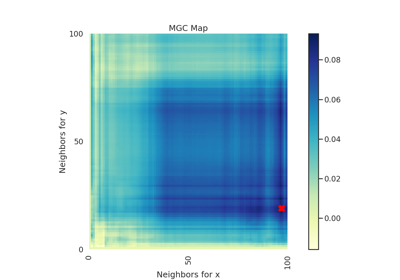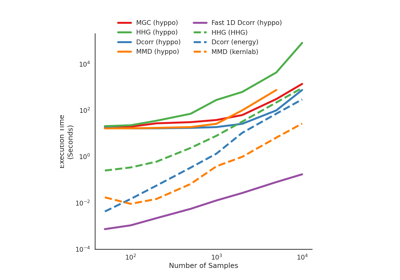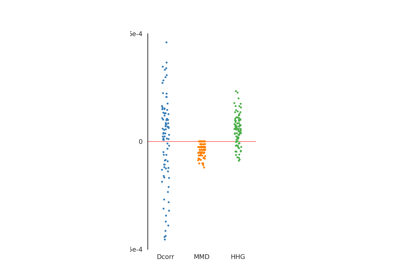HHG¶
-
class
hyppo.independence.HHG(compute_distance='euclidean', **kwargs)¶ Heller Heller Gorfine (HHG) test statistic and p-value.
This is a powerful test for independence based on calculating pairwise euclidean distances and associations between these distance matrices. The test statistic is a function of ranks of these distances, and is consistent against similar tests [1]. It can also operate on multiple dimensions [1].
The statistic can be derived as follows [1]:
Let \(x\) and \(y\) be \((n, p)\) samples of random variables \(X\) and \(Y\). For every sample \(j \neq i\), calculate the pairwise distances in \(x\) and \(y\) and denote this as \(d_x(x_i, x_j)\) and \(d_y(y_i, y_j)\). The indicator function is denoted as \(\mathbb{1} \{ \cdot \}\). The cross-classification between these two random variables can be calculated as
\[A_{11} = \sum_{k=1, k \neq i,j}^n \mathbb{1} \{ d_x(x_i, x_k) \leq d_x(x_i, x_j) \} \mathbb{1} \{ d_y(y_i, y_k) \leq d_y(y_i, y_j) \}\]and \(A_{12}\), \(A_{21}\), and \(A_{22}\) are defined similarly. This is organized within the following table:
\(d_x(x_i, \cdot) \leq d_x(x_i, x_j)\)
\(d_x(x_i, \cdot) \leq d_x(x_i, x_j)\)
\(d_x(x_i, \cdot) \leq d_x(x_i, x_j)\)
\(A_{11} (i,j)\)
\(A_{12} (i,j)\)
\(A_{1 \cdot} (i,j)\)
\(d_x(x_i, \cdot) > d_x(x_i, x_j)\)
\(A_{21} (i,j)\)
\(A_{22} (i,j)\)
\(A_{2 \cdot} (i,j)\)
\(A_{\cdot 1} (i,j)\)
\(A_{\cdot 2} (i,j)\)
\(n - 2\)
Here, \(A_{\cdot 1}\) and \(A_{\cdot 2}\) are the column sums, \(A_{1 \cdot}\) and \(A_{2 \cdot}\) are the row sums, and \(n - 2\) is the number of degrees of freedom. From this table, we can calculate the Pearson's chi squared test statistic using,
\[S(i, j) = \frac{(n-2) (A_{12} A_{21} - A_{11} A_{22})^2} {A_{1 \cdot} A_{2 \cdot} A_{\cdot 1} A_{\cdot 2}}\]and the HHG test statistic is then,
\[\mathrm{HHG}_n (x, y) = \sum_{i=1}^n \sum_{j=1, j \neq i}^n S(i, j)\]The p-value returned is calculated using a permutation test using
hyppo.tools.perm_test.- Parameters
compute_distance (
str,callable, orNone, default:"euclidean") -- A function that computes the distance among the samples within each data matrix. Valid strings forcompute_distanceare, as defined insklearn.metrics.pairwise_distances,From scikit-learn: [
"euclidean","cityblock","cosine","l1","l2","manhattan"] See the documentation forscipy.spatial.distancefor details on these metrics.From scipy.spatial.distance: [
"braycurtis","canberra","chebyshev","correlation","dice","hamming","jaccard","kulsinski","mahalanobis","minkowski","rogerstanimoto","russellrao","seuclidean","sokalmichener","sokalsneath","sqeuclidean","yule"] See the documentation forscipy.spatial.distancefor details on these metrics.
Set to
Noneor"precomputed"ifxandyare already distance matrices. To call a custom function, either create the distance matrix before-hand or create a function of the formmetric(x, **kwargs)wherexis the data matrix for which pairwise distances are calculated and**kwargsare extra arguements to send to your custom function.**kwargs -- Arbitrary keyword arguments for
compute_distance.
Methods Summary
|
Helper function that calculates the HHG test statistic. |
|
Calculates the HHG test statistic and p-value. |
-
HHG.statistic(x, y)¶ Helper function that calculates the HHG test statistic.
- Parameters
x,y (
ndarray) -- Input data matrices.xandymust have the same number of samples. That is, the shapes must be(n, p)and(n, q)where n is the number of samples and p and q are the number of dimensions. Alternatively,xandycan be distance matrices, where the shapes must both be(n, n).- Returns
stat (
float) -- The computed HHG statistic.
-
HHG.test(x, y, reps=1000, workers=1)¶ Calculates the HHG test statistic and p-value.
- Parameters
x,y (
ndarray) -- Input data matrices.xandymust have the same number of samples. That is, the shapes must be(n, p)and(n, q)where n is the number of samples and p and q are the number of dimensions. Alternatively,xandycan be distance matrices, where the shapes must both be(n, n).reps (
int, default:1000) -- The number of replications used to estimate the null distribution when using the permutation test used to calculate the p-value.workers (
int, default:1) -- The number of cores to parallelize the p-value computation over. Supply-1to use all cores available to the Process.
- Returns
Examples
>>> import numpy as np >>> from hyppo.independence import HHG >>> x = np.arange(7) >>> y = x >>> stat, pvalue = HHG().test(x, y) >>> '%.1f, %.2f' % (stat, pvalue) '160.0, 0.00'
In addition, the inputs can be distance matrices. Using this is the, same as before, except the
compute_distanceparameter must be set toNone.>>> import numpy as np >>> from hyppo.independence import HHG >>> x = np.ones((10, 10)) - np.identity(10) >>> y = 2 * x >>> hhg = HHG(compute_distance=None) >>> stat, pvalue = hhg.test(x, y) >>> '%.1f, %.2f' % (stat, pvalue) '0.0, 1.00'


